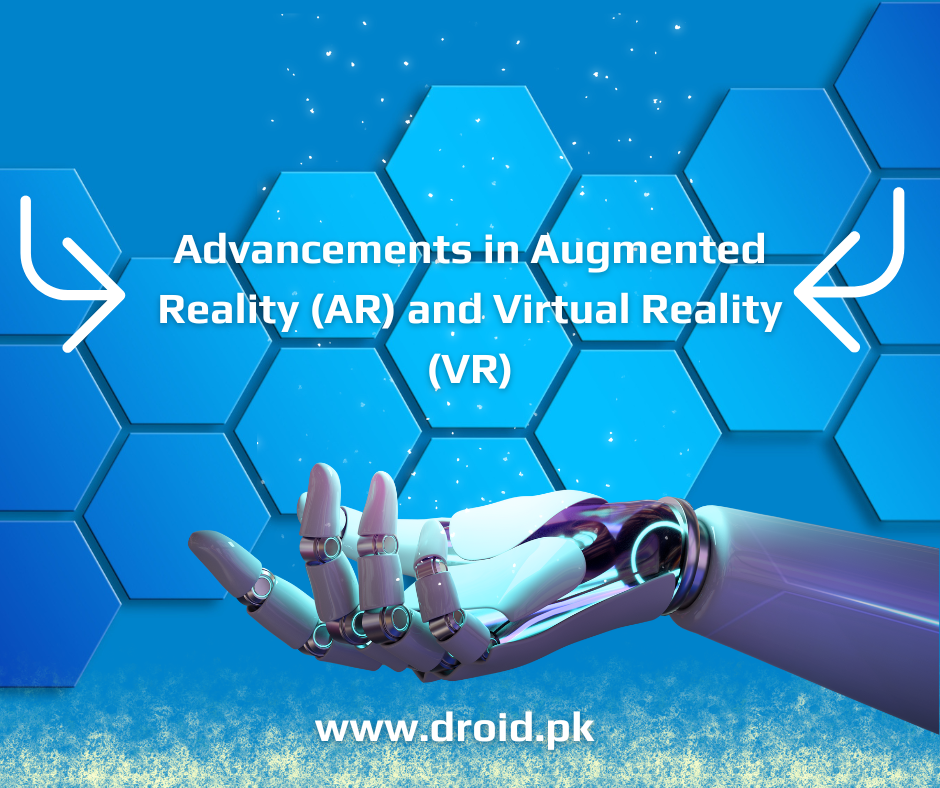
Advancements in Augmented Reality (AR) and Virtual Reality (VR)
Share

Augmented Reality (AR) and Virtual Reality (VR) technologies have rapidly evolved in recent years, offering exciting possibilities across various industries. From enhancing gaming experiences to revolutionizing healthcare, AR and VR have become increasingly prevalent and impactful. In this article, we will explore the advancements in both AR and VR technologies, their applications, and the potential they hold for the future.
AR and VR are immersive technologies that aim to bridge the gap between the digital and physical worlds. AR enhances the real world by overlaying digital information, while VR transports users to entirely virtual environments. These technologies have seen significant advancements, enabling more realistic and interactive experiences.
What is Augmented Reality (AR)?
AR refers to the integration of digital information into the user's real-world environment. It overlays computer-generated images, videos, or other content onto the user's view of the physical world. AR can be experienced through various devices, including smartphones, tablets, smart glasses, and heads-up displays.
Applications of AR
AR finds applications in diverse fields, including gaming, education, healthcare, architecture, and retail. In gaming, AR allows users to interact with virtual characters and objects in their real surroundings, creating a more immersive and interactive experience. In education, AR offers interactive and engaging learning opportunities, allowing students to visualize complex concepts. Healthcare professionals use AR for surgical planning, patient education, and training. Architects and designers can use AR to showcase their projects in a more tangible way, enabling clients to visualize designs in real-world contexts. Retailers have adopted AR to provide virtual try-on experiences, allowing customers to visualize products before purchasing.
What is Virtual Reality (VR)?
VR is a technology that simulates a completely artificial environment, immersing users in a virtual world. It typically involves wearing a VR headset that tracks the user's head movements and displays content accordingly. VR experiences can be highly interactive, allowing users to explore and interact with the virtual environment.
Applications of VR
VR has found applications in various industries, including gaming, training and simulation, healthcare, tourism, and design. In gaming, VR provides users with a truly immersive experience, transporting them to virtual worlds where they can interact with the environment and characters. VR-based training and simulation are used in fields such as aviation, military, and industrial training, providing realistic and safe environments for practice. In healthcare, VR is used for pain management, exposure therapy, and surgical simulations. VR also enables virtual tourism experiences, allowing users to visit iconic destinations without leaving their homes. Architects and designers use VR to create virtual walkthroughs of buildings and spaces, enabling clients to experience designs before they are constructed.
Advancements in Augmented Reality
AR technology has seen significant advancements in recent years, improving the user experience and expanding its capabilities.
AR Hardware Innovations
Hardware manufacturers have developed more compact and lightweight AR devices, making them more accessible and comfortable to use. Smart glasses, such as the Microsoft HoloLens and Magic Leap One, offer hands-free AR experiences with spatial audio and gesture recognition capabilities. These advancements have opened up new possibilities for professionals and consumers alike.
AR Software Developments
The development of sophisticated AR software platforms and tools has empowered creators to build immersive and interactive AR experiences. These tools enable the integration of 3D models, animations, and interactive elements into the real world. With the help of AR development kits and frameworks, developers can easily create AR applications for a wide range of devices.
Real-World Applications
AR has made a significant impact across multiple industries. In the retail sector, AR allows customers to virtually try on clothing and accessories, enhancing the online shopping experience. In healthcare, AR is used for medical training, enabling students and professionals to practice complex procedures in a safe and controlled environment. AR also finds applications in industrial maintenance, where technicians can access real-time instructions and overlays for repairing and troubleshooting equipment.
Advancements in Virtual Reality
VR technology has undergone remarkable advancements, enhancing the level of immersion and realism in virtual experiences.
VR Headsets and Devices
The development of high-quality VR headsets, such as the Oculus Rift, HTC Vive, and PlayStation VR, has brought VR experiences to a broader audience. These headsets offer improved graphics, wider field of view, and better tracking, creating more immersive virtual environments. Additionally, standalone VR devices, like the Oculus Quest, provide untethered experiences, allowing users to move freely within the virtual space.
VR Content Creation Tools
Content creation tools and platforms have evolved, enabling creators to build captivating VR experiences. These tools offer intuitive interfaces for designing virtual environments, incorporating interactive elements, and scripting interactions. With the availability of user-friendly VR content creation tools, more individuals and organizations can participate in VR content creation.
Real-World Applications
VR has made a significant impact in various industries. In gaming, VR has revolutionized the way games are played, providing an unprecedented level of immersion and interactivity. VR-based training simulations are being used in fields such as aviation, healthcare, and defense, offering realistic scenarios for skill development. Virtual reality is also being explored for therapeutic purposes, including pain management, phobia treatment, and PTSD therapy.
The Impact of AR and VR in Industries
AR and VR technologies have the potential to transform numerous industries, offering unique benefits and opportunities.
Gaming and Entertainment
AR and VR have revolutionized the gaming and entertainment industries. They provide immersive experiences, allowing players to engage with virtual worlds and characters in unprecedented ways. From interactive storytelling to virtual theme parks, AR and VR are pushing the boundaries of entertainment.
Education and Training
AR and VR have the power to reshape education and training. In classrooms, AR can enhance learning by overlaying digital information on textbooks, providing interactive demonstrations, and enabling virtual field trips. VR-based training simulations offer safe and realistic environments for practicing skills, such as surgical procedures, emergency response, and complex machinery operation.
Healthcare and Medicine
AR and VR technologies are making significant contributions to healthcare and medicine. In surgical planning, AR enables surgeons to visualize patient anatomy and plan procedures more accurately. VR is being used for pain management, distraction during medical procedures, and exposure therapy for phobias and anxiety disorders. VR-based rehabilitation programs are helping patients recover motor skills and regain mobility.
Architecture and Design
AR and VR are transforming the architecture and design industries. Architects and designers can use AR to overlay digital models onto physical spaces, enabling clients to visualize designs in real-world contexts. VR allows stakeholders to experience architectural designs through immersive virtual walkthroughs, providing a more accurate representation of the final product.
Retail and E-commerce
AR and VR are reshaping the retail and e-commerce landscape. AR-powered virtual try-on experiences enable customers to visualize how products would look on them before making a purchase. VR-based virtual showrooms and immersive online stores offer unique and engaging shopping experiences, allowing customers to explore products in a more interactive way.
Future Trends and Possibilities
The future of AR and VR holds exciting possibilities, with ongoing advancements and emerging technologies pushing the boundaries even further.
Integration with Artificial Intelligence
The integration of AR, VR, and artificial intelligence (AI) is expected to unlock new levels of interactivity and personalization. AI algorithms can enhance AR and VR experiences by analyzing user behavior, preferences, and environmental data to deliver personalized content and interactions.
Mixed Reality and Extended Reality
The convergence of AR and VR has given rise to mixed reality (MR) and extended reality (XR) experiences. MR combines elements of both AR and VR, seamlessly blending digital content with the real world. XR encompasses the spectrum of reality-altering technologies, including AR, VR, and MR, offering a more holistic and versatile range of experiences.
The Potential of 5G Technology
The deployment of 5G networks promises faster and more reliable connectivity, which will be instrumental in supporting AR and VR applications. With lower latency and higher bandwidth, 5G networks will enable more immersive and responsive AR and VR experiences, fostering the growth of these technologies.
Conclusion
The advancements in augmented reality (AR) and virtual reality (VR) technologies have revolutionized industries and transformed the way we perceive and interact with digital content. From gaming and entertainment to education, healthcare, and design, AR and VR offer unprecedented possibilities and experiences. As these technologies continue to evolve and integrate with other emerging technologies, we can expect even more exciting advancements in the future.
FAQs
-
What is the difference between AR and VR? AR overlays digital information onto the real world, while VR immerses users in a completely virtual environment.
-
How is AR being used in education? AR is used in education to enhance learning experiences by providing interactive and visual explanations of complex concepts.
-
Can VR help with pain management? Yes, VR has been used effectively for pain management by providing immersive experiences that distract and relax patients.
-
Is AR only limited to mobile devices? No, AR can be experienced through various devices, including smartphones, tablets, smart glasses, and heads-up displays.
-
What are some challenges in adopting AR and VR technologies? Challenges include high hardware costs, technological limitations, user acceptance, and the need for robust content creation tools.
